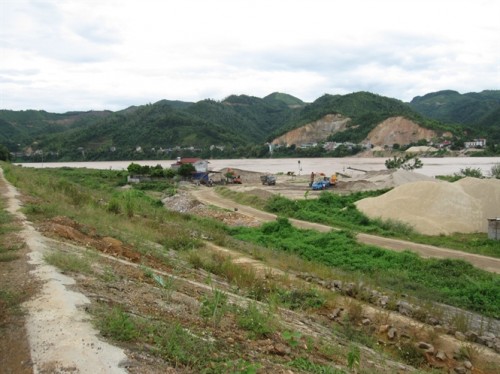

Instead of using the land for building-material shops, businesses instead built multi-storey buildings on the land.
Dozens of thousands of square meters of land in the Da River’s breakwater area were originally leased for businesses to house building materials.
In Dong Tien Ward of Hoa Binh City, hundreds of people in 141 households live on the other side of the river bank. Local residents have noticed violent floods causing terrible whirlpools and sweeping away big blocks of soil, snapping up the mainland and shaking people’s houses.
It is clear that the protection and water drainage corridors of the Da River’s dyke system have been seriously compromised by local authorities at different levels.
In October 2002, the Land Registry Department, which is now the Hoa Binh provincial Department for Natural Resources and the Environment, agreed to lease 31,900 square meters of the land in Thinh Giang Ward in Hoa Binh City to the Inland Waterways Transportation Company.
Later, 9,345 square meters were taken back by the provincial authorities in 2004. The remaining area is still being used by the company.
In December 2007, the provincial authorities released a decision to lease 6,296 square meters of land in the protection and water drainage corridors to Xuan Quynh Private Enterprise. It was allowed to use the land for 50 years to carry out production and business activities.
In October 2008, Xuan Quynh got the nod from provincial authorities to lease another land plot of 1,000 square meters.
Following Xuan Quynh, a series of other enterprises, supported by the local environment department, have asked to lease land to run their production and business in the dyke area.
The department proposed to the provincial authorities to lease 12,000 square meters of land to Nam Hai Construction and Transport Services and 9,000 square meters to Huong Trang Company.
In documents related to the land lease, the local authorities said that the enterprises can use land plots as places for gathering and storing building materials.
However, instead of building-material storehouses, many solid construction works have been set up which have been used as houses and offices.
The land tenants have also appropriated land plots nearby and planted trees to expand their “territories”, though they know that high-rises and greenery will hinder water drainage and cause danger in case of floods.
Meanwhile, the riverbed of the section located only one kilometer from the Song Da hydropower plant is getting narrower because of the people’s attempt to enlarge their land plots.